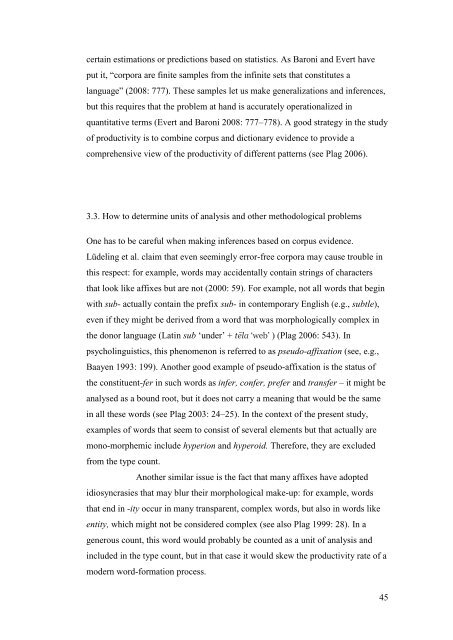The morphological productivity of selected ... - Helda - Helsinki.fi
The morphological productivity of selected ... - Helda - Helsinki.fi
The morphological productivity of selected ... - Helda - Helsinki.fi
You also want an ePaper? Increase the reach of your titles
YUMPU automatically turns print PDFs into web optimized ePapers that Google loves.
certain estimations or predictions based on statistics. As Baroni and Evert have<br />
put it, “corpora are <strong>fi</strong>nite samples from the in<strong>fi</strong>nite sets that constitutes a<br />
language” (2008: 777). <strong>The</strong>se samples let us make generalizations and inferences,<br />
but this requires that the problem at hand is accurately operationalized in<br />
quantitative terms (Evert and Baroni 2008: 777–778). A good strategy in the study<br />
<strong>of</strong> <strong>productivity</strong> is to combine corpus and dictionary evidence to provide a<br />
comprehensive view <strong>of</strong> the <strong>productivity</strong> <strong>of</strong> different patterns (see Plag 2006).<br />
3.3. How to determine units <strong>of</strong> analysis and other methodological problems<br />
One has to be careful when making inferences based on corpus evidence.<br />
Lüdeling et al. claim that even seemingly error-free corpora may cause trouble in<br />
this respect: for example, words may accidentally contain strings <strong>of</strong> characters<br />
that look like af<strong>fi</strong>xes but are not (2000: 59). For example, not all words that begin<br />
with sub- actually contain the pre<strong>fi</strong>x sub- in contemporary English (e.g., subtle),<br />
even if they might be derived from a word that was <strong>morphological</strong>ly complex in<br />
the donor language (Latin sub ‘under’ + tēla ‘web’ ) (Plag 2006: 543). In<br />
psycholinguistics, this phenomenon is referred to as pseudo-af<strong>fi</strong>xation (see, e.g.,<br />
Baayen 1993: 199). Another good example <strong>of</strong> pseudo-af<strong>fi</strong>xation is the status <strong>of</strong><br />
the constituent-fer in such words as infer, confer, prefer and transfer – it might be<br />
analysed as a bound root, but it does not carry a meaning that would be the same<br />
in all these words (see Plag 2003: 24–25). In the context <strong>of</strong> the present study,<br />
examples <strong>of</strong> words that seem to consist <strong>of</strong> several elements but that actually are<br />
mono-morphemic include hyperion and hyperoid. <strong>The</strong>refore, they are excluded<br />
from the type count.<br />
Another similar issue is the fact that many af<strong>fi</strong>xes have adopted<br />
idiosyncrasies that may blur their <strong>morphological</strong> make-up: for example, words<br />
that end in -ity occur in many transparent, complex words, but also in words like<br />
entity, which might not be considered complex (see also Plag 1999: 28). In a<br />
generous count, this word would probably be counted as a unit <strong>of</strong> analysis and<br />
included in the type count, but in that case it would skew the <strong>productivity</strong> rate <strong>of</strong> a<br />
modern word-formation process.<br />
45
















